at TA = 25°C, AVDD = 3.3 V, IOVDD = 3.3
V, fIN = 1-kHz sinusoidal signal, fS = 48 kHz, 32-bit audio
data, BCLK = 256 × fS, TDM slave mode, PLL on, DRE_LVL = –36 dB,
differential
input, channel gain = 0 dB, and linear phase decimation filter
(unless otherwise noted); all performance measurements are done with a 20-kHz,
low-pass filter, and an A-weighted filter
 Figure 7-4 THD+N
vs Input Amplitude With
DRE Enabled
Figure 7-4 THD+N
vs Input Amplitude With
DRE Enabled Figure 7-6 THD+N
vs Input Amplitude With
DRE Enabled
Figure 7-6 THD+N
vs Input Amplitude With
DRE Enabled
| Differential input with AVDD = 1.8 V and VREF = 1.375
V |
Figure 7-8 THD+N
vs Input Amplitude With
DRE Enabled Figure 7-10 THD+N
vs Input Frequency With a –60-dBr Input
Figure 7-10 THD+N
vs Input Frequency With a –60-dBr Input Figure 7-12 THD+N
vs Input Frequency With a –1-dBr Input
Figure 7-12 THD+N
vs Input Frequency With a –1-dBr Input Figure 7-14 Input-Referred Noise vs Channel Gain
Figure 7-14 Input-Referred Noise vs Channel Gain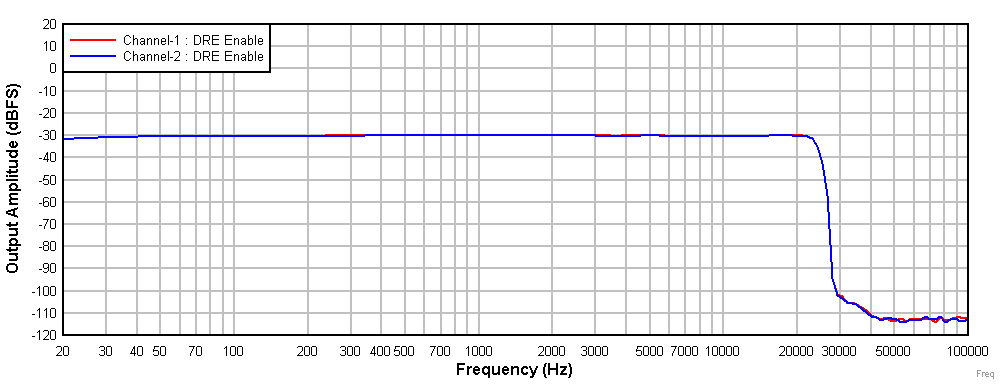 Figure 7-16 Frequency Response With a –30-dBr Input
Figure 7-16 Frequency Response With a –30-dBr Input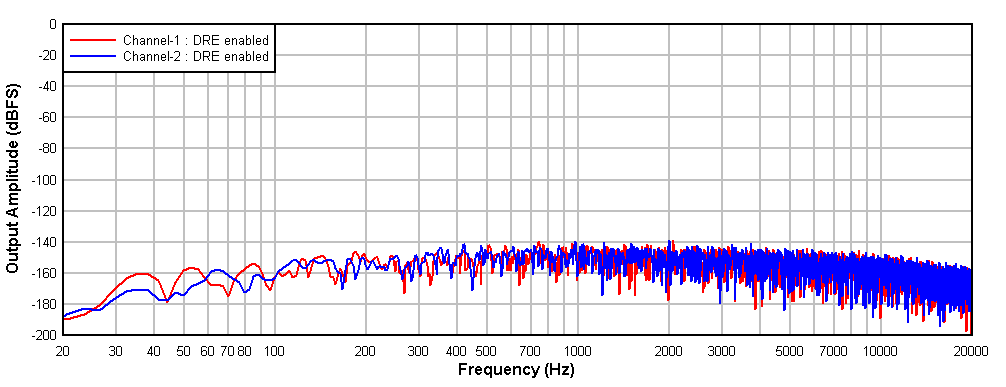 Figure 7-18 Differential
FFT With Idle Input With DRE Enabled
Figure 7-18 Differential
FFT With Idle Input With DRE Enabled
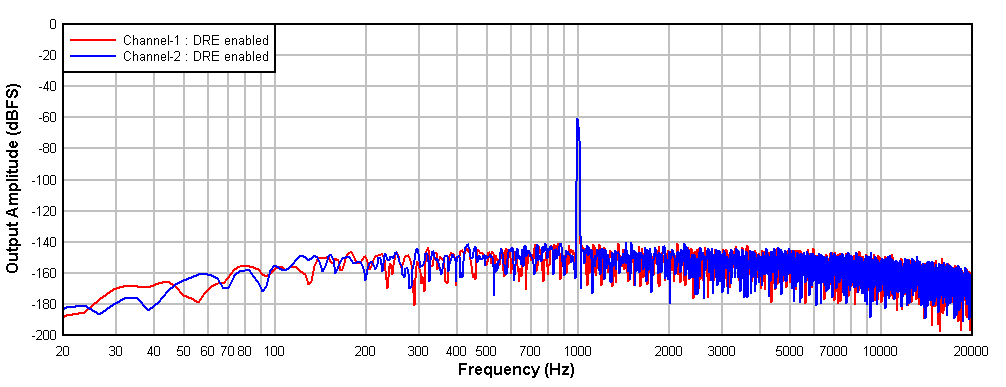 Figure 7-20 Differential
FFT With a –60-dBr Input With DRE
Enabled
Figure 7-20 Differential
FFT With a –60-dBr Input With DRE
EnabledFigure 7-22 Single Ended FFT With Idle Input With DRE Enabled
Figure 7-24 Single Ended FFT With a –60-dBr Input With DRE
Enabled  Figure 7-26 Differential
FFT With a –1-dBr Input With DRE
Enabled
Figure 7-26 Differential
FFT With a –1-dBr Input With DRE
Enabled Figure 7-28 PDM
Input THD+N vs Input Amplitude
Figure 7-28 PDM
Input THD+N vs Input Amplitude  Figure 7-30 PDM
Input FFT With a –60-dBr Input
Figure 7-30 PDM
Input FFT With a –60-dBr Input Figure 7-5 THD+N
vs Input Amplitude With
DRE Disabled
Figure 7-5 THD+N
vs Input Amplitude With
DRE Disabled Figure 7-7 THD+N
vs Input Amplitude With
DRE Disabled
Figure 7-7 THD+N
vs Input Amplitude With
DRE Disabled
| Differential input with AVDD = 1.8 V and VREF = 1.375
V |
Figure 7-9 THD+N
vs Input Amplitude With
DRE Disabled Figure 7-11 THD+N
vs Input Frequency With a –60-dBr Input
Figure 7-11 THD+N
vs Input Frequency With a –60-dBr Input Figure 7-13 Input-Referred Noise vs Channel Gain
Figure 7-13 Input-Referred Noise vs Channel Gain Figure 7-15 Frequency Response With a –12-dBr Input
Figure 7-15 Frequency Response With a –12-dBr Input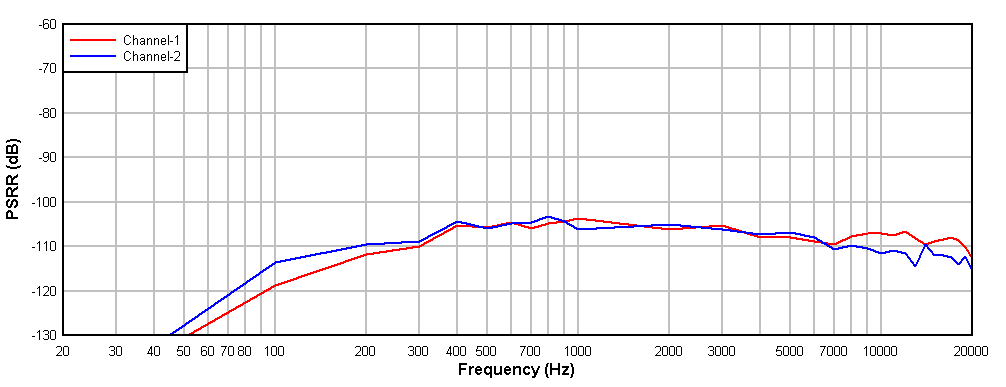 Figure 7-17 Power-Supply Rejection Ratio vs Ripple Frequency With 100-mVPP
Amplitude
Figure 7-17 Power-Supply Rejection Ratio vs Ripple Frequency With 100-mVPP
Amplitude Figure 7-19 Differential
FFT With Idle Input With DRE
Disabled
Figure 7-19 Differential
FFT With Idle Input With DRE
Disabled Figure 7-21 Differential
FFT With a –60-dBr Input With DRE
Disabled
Figure 7-21 Differential
FFT With a –60-dBr Input With DRE
DisabledFigure 7-23 Single Ended FFT With Idle Input With DRE
Disabled Figure 7-25 Single Ended FFT With a –60-dBr Input With DRE
Disabled  Figure 7-27 Differential
FFT With a –1-dBr Input With DRE
Disabled
Figure 7-27 Differential
FFT With a –1-dBr Input With DRE
Disabled Figure 7-29 PDM
Input THD+N vs Input Frequency With a
Figure 7-29 PDM
Input THD+N vs Input Frequency With a
–20-dBr
Input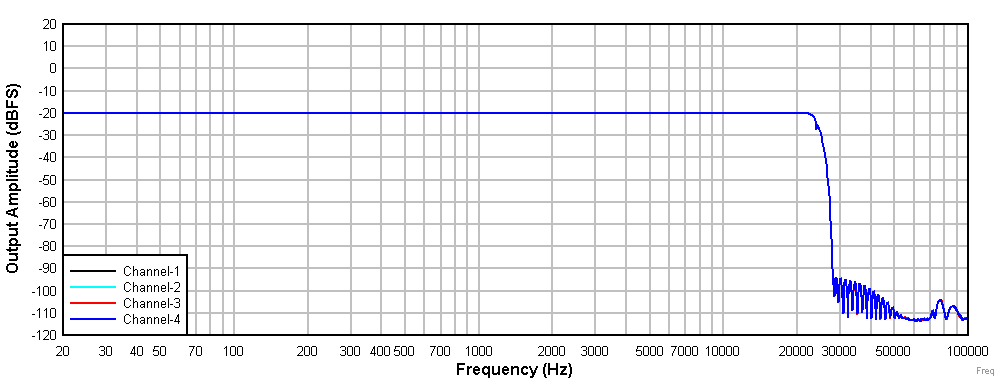 Figure 7-31 PDM
Input Frequency Response With a
Figure 7-31 PDM
Input Frequency Response With a
–20-dBr
Input






















